![]()
![]()
![]()
Use LEFT and RIGHT arrow keys to navigate between flashcards;
Use UP and DOWN arrow keys to flip the card;
H to show hint;
A reads text to speech;
40 Cards in this Set
- Front
- Back
|
Ecosystems
|
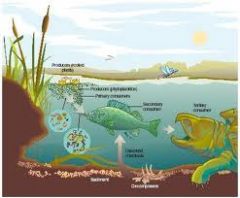
all organisms within a community as well as all biotic and abiotic factors with which they interact
|
|
|
Law of Conservation of Energy:
|

energy can neither be created nor destroyed, only transformed
|
|
|
Second Law of Thermodynamics:
|
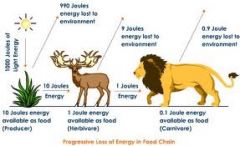
energy transfers/transformations are not completely efficient –
some energy will be lost as heat |
|
|
Primary consumers
|

heterotrophs feeding directly on plants (herbivores)
|
|
|
Secondary consumers
|

heterotrophs feeding directly on herbivores (carnivores)
|
|
|
Tertiary consumers
|

heterotrophs feeding on other carnivores (carnivores
|
|
|
Detritivores
|
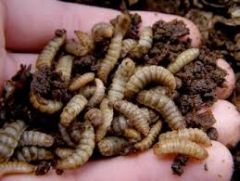
heterotrophs that obtain energy from dead/decaying organic material (detritus) and
recycle nutrients back to producers 1. EX prokaryotes, protists, fungi |
|
|
Primary Production
|
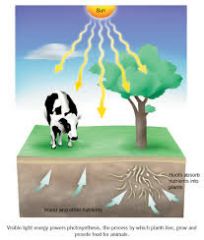
amount of light energy converted into chemical energy by producers during a
given time |
|
|
Gross primary production
|

amount of light energy converted into chemical energy by
producers during a given time |
|
|
Net primary production
|

gross primary production minus the energy used by producers during respiration
a. Determined by (primary producers): i. size of area covered ii. efficiency (GROSS PP) - (used E) = NPP |
|
|
Primary Production in Aquatic Ecosystems
|
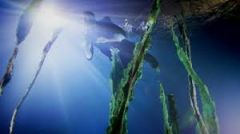
1. 50 %+ solar radiation is absorbed in the first meter of water
2. solar radiation increase from the poles to the equator where the greatest amount of light hits the earth |
|
|
Nutrient limitation
|
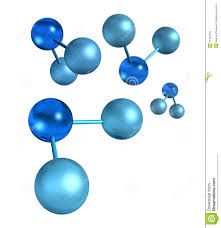
element that must be added in order for production to increase in a
particular area a) marine limiting nutrients: i. phosphorus ii. Nitrogen iii. iron |
|
|
Upwellings
|
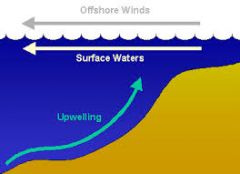
when nutrient-rich waters circulate to the ocean’s surface
a. results in high primary production |
|
|
Eutrophication
|
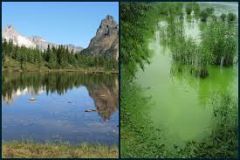
process in which nutrients (P, N) become highly concentrated in a body of
water results in increased algal growth a. mainly human sources (agriculture, sewage) |
|
|
temperature and moisture are two key factors in
|
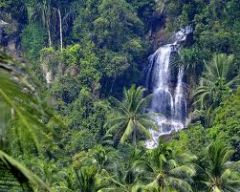
terrestrial primary production
a. highest primary production = tropical rainforest b. lowest primary production = tundra and desert |
|
|
Actual evapotranspiration
|
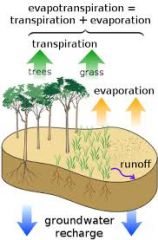
annual amount of water transpired by plants and evaporated from
landscapes a. greater the precipitation and solar radiation, the greater the evapotranspiration |
|
|
Secondary Production
|

amount of chemical energy converted into biomass by heterotrophs
during a given amount of time |
|
|
Trophic Efficiency:
|
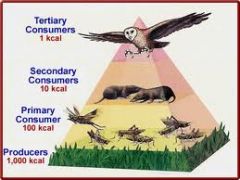
percentage of production (energy) transferred from one trophic level to the
next a. 10% energy is transferred between levels b. 90% energy is lost between levels |
|
|
Green World Hypothesis:
|

predators (carnivores, parasites, diseases, etc.) hold terrestrial
herbivores in check, preventing them from consuming excessive amounts of plant biomass a. herbivores annually consume less than 17% of total plant biomass |
|
|
Keeping Herbivores in Check:
|

a. Intraspecific competition
b. Interspecific interactions c. Abiotic factors (climate) d. Nutrient limitations e. Plant defenses |
|
|
Biogeochemical Cycles:
|
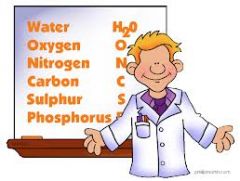
nutrients cycles involving both biotic and abiotic components
1. carbon (global) 2. water (global) 3. nitrogen (local) 4. phosphorous (local) |
|
|
Decomposition
|

1. Detritivore: decomposer
2. rate of nutrient cycling is dependent upon decomposition rate 3. tropical rainforest – 10% nutrients in soil a. faster nutrient cycling 4. temperate forest – 50% nutrients in soil a. slower nutrient cycling |
|
|
Nutrient Enrichment
|
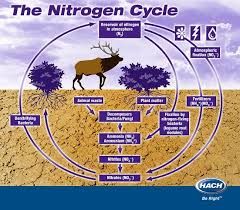
1. nitrogen is the main nutrient lost in agriculture
2. synthetic fertilizers increase nitrogen in the soil 3. legumes increase nitrogen in the soil |
|
|
Contamination of Aquatic Ecosystems
|
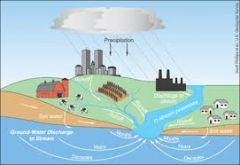
amount of nutrients added (N/P) that can be absorbed by plants without
damaging the ecosystem integrity 2. excess nutrients leach into groundwater or runoff into aquatic ecosystems a. contaminates water supplies b. chokes waterways (eutrophication) c. kills fish |
|
|
Sources of contamination:
|
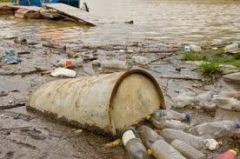
a. fertilizer runoff – fertilizer/landscaping
b. sewage/industrial waste c. animal waste runoff |
|
|
Results of contamination:
|
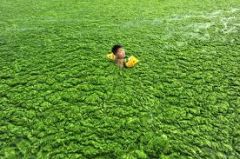
a. algal blooms
b. oxygen saturation during photosynthesis (day) c. oxygen depletion during respiration (night) |
|
|
Acid precipitation
|
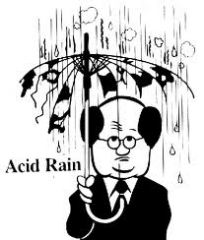
rain, snow, sleet or fog with a pH of less than 5.6
a. burning of wood, coal or fossil fuels releases sulfur and nitrogen which reacts with water forming sulfuric and nitric acids |
|
|
Results of Acid Precipitation:
|
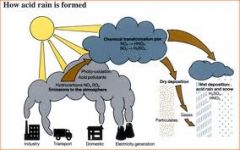
a. lowers the pH of aquatic ecosystems
b. alters soil chemistry of terrestrial ecosystems |
|
|
Bioaccumulation
|
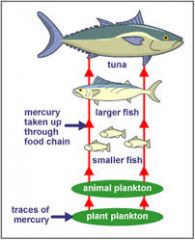
increasing concentrations of potentially toxic substances in living
organisms; easily ingested, but not biodegradable (in the individual, build up of a toxic substance due to not being able to degrade) |
|
|
Biomagnification:
|
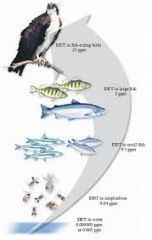
increasing concentrations of potentially toxic substances through food chains, exponentially increasing at each level
|
|
|
First Generation Pesticides
|
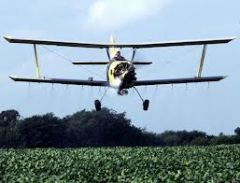
a. heavy metals (As, Pb, Hg)
b. expensive to produce c. persistent in the environment d. toxic to all living organisms e. insects developed resistance |
|
|
Second Generation Pesticides
|

a. synthetic organics (DDT)
b. inexpensive to produce c. persisted in the environment d. toxic to insects only – at first e. covered a broad spectrum |
|
|
Environmental Toxins – DDT
|

1. DDT accumulated in the tissues of eagles, interfering with the deposition of Calcium eggshells
2. during incubation, the egg shells would break resulting in a significant decline in reproductive rates |
|
|
Atmospheric Carbon Dioxide
|
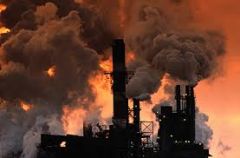
1. CO2 concentration has been increasing since the Industrial Revolution due to combustion of
fossil fuels and burning of enormous quantities of wood (also, deforestation) |
|
|
Greenhouse effect:
|
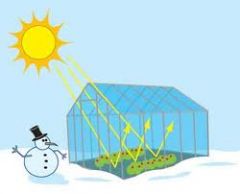
carbon dioxide, water vapor, etc intercept much of the reflected solar
radiation from earth’s surface, reflecting some of it back to earth |
|
|
Global warming
|
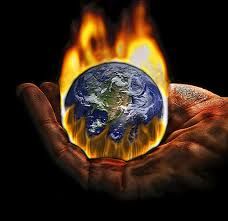
increase in average temperature of earths near-surface air and oceans
|
|
|
Results from Global Warming:
|

a. shifting precipitation patterns
b. melting polar ice caps c. rising sea levels (100 m) d. coastal flooding (150 km) e. mass extinctions |
|
|
Ozone layer:
|

17 – 25 km high layer in earth’s atmosphere containing high concentrations of
ozone (O3), blocking 97 – 99% of solar ultraviolet radiation |
|
|
Ozone Layer Depletion:
|
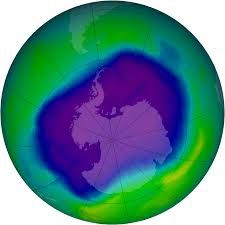
a. thinning since 1975
b. due to CFC’s (ChlorafloraCarbons ??) c. Most apparent over Antarctica |
|
|
Consequences of Ozone Layer Depletion:
|
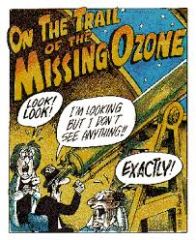
a. increase in cases of skin cancer, cataracts
b. adverse effects on ecosystems c. adverse effects on crops |

